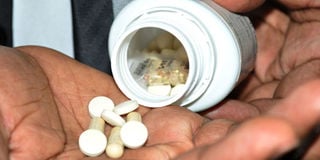How can you tell a drug is counterfeit?

Photo by Rachel Mabala
What you need to know:
WHO says most cases of counterfeit drugs have been reported in developing countries such as Uganda. The common counterfeited drugs include antibiotics, hormones, analgesics, steroids, and anti-histamines
Many people have heard of the term counterfeit. But how many know what it means, or in this case, how to identify medicines that are counterfeit? According to the World Health Organisation (WHO), the term counterfeit drug may be used to describe any medicine made by someone other than the genuine manufacturer, by copying or imitating an original product without authority or right, with the aim of defrauding the public and marketing the copy drug as an original one.
WHO says most cases of counterfeit drugs have been reported in developing countries such as Uganda. The common counterfeited drugs include antibiotics, hormones, analgesics, steroids, and anti-histamines.
Counterfeiting applies to both branded and generic drugs. A counterfeited medicine may have the correct ingredients in the right or required quantities. It may also contain the wrong ingredients. In some cases, it may not have any of the active ingredients as stated on the label. In addition, the product might actually contain the right ingredients but is mislabeled.
So how does one know if they are taking a counterfeit drug or not.
•Just like other products, it starts from the outlook. The name of the drug for instance may look similar, but may differ in the spelling, making it almost unnoticeable for someone who is not keen on checking the labels before buying a particular drug.
•The packaging can also give a person an indication that the medicine they are buying could be counterfeit or not. If normally a drug appears in a blue and white pack, and then suddenly you are getting it in yellow and green, it would be wise to ascertain that you are taking the same medication.
•Some medicines come in seals. So when you suddenly get the same medicine without the seal, it should be a pointer to you that something is wrong.
•Distorted manufacture, expiry dates and batch numbers are also warning signs that a drug may be counterfeit.
•The colour, size or smell should also be taken into consideration when buying medication.
The writer is a pharmacist




